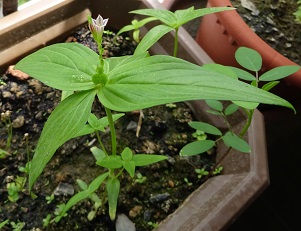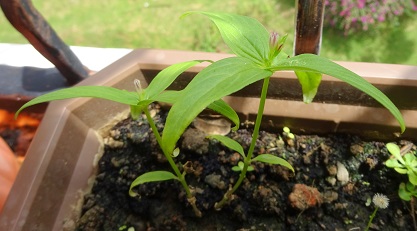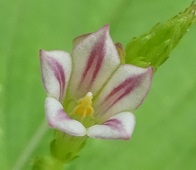| Home | Nature Weekly Index |
31 January 2016 | Pinkroot | Spigelia anthelmia |

 Spigelia anthelmia is native of the West Indies and of South
America. Its more popular relative is Spigelia marilandica sold as an ornamental plant in the United States of
America. Spigelia anthelmia is the only representative of this genus in Singapore, at least in the wild.
This plant was first reported in India in 1987 and now naturalized in Africa, Southeast Asia, Sri Lanka and Australia [1].
In Southeast Asia, it was first reported in Indonesia, Thailand and Malaysia in 1989, 2006 and 2013 respectively
[2-4].
Spigelia anthelmia is native of the West Indies and of South
America. Its more popular relative is Spigelia marilandica sold as an ornamental plant in the United States of
America. Spigelia anthelmia is the only representative of this genus in Singapore, at least in the wild.
This plant was first reported in India in 1987 and now naturalized in Africa, Southeast Asia, Sri Lanka and Australia [1].
In Southeast Asia, it was first reported in Indonesia, Thailand and Malaysia in 1989, 2006 and 2013 respectively
[2-4].
Plants in this genus is commonly known as Pinkroot. The main uses of Spigelia anthelmia is in homeopathy to expel parasitic worms from the body. Its anti-parasitic worm effect was recorded way back in 1751 by a guy name Patrick Browne. In a more recent research, its worm-expelling effect was not as great when compared to another 2 plants, Heliotropium indicum and Cassia fistula [5]. The whole plant is poisonous as it contains the alkaloid spigeline or spiganthine that acts upon the heart. However, it is also promoted as remedy in pericarditis and other diseases of the heart in homeopathy.


 The short tubular flower of about 5 millimetres (mm) long is white with a pair of purple strips that run parallel to the
length of each of the 5 petals. It starts to bloom in the afternoon at about 2 pm, closes before sunset and drop off the
next day. The warty fruit is a 2-lobed capsule. Dispersion of the seeds is via an explosive mechanism with the seed pods
split open abruptly and send the seeds flying off in different directions, similar to that of the
balsam fruits. Each seed is about 1 millimetre long.
The short tubular flower of about 5 millimetres (mm) long is white with a pair of purple strips that run parallel to the
length of each of the 5 petals. It starts to bloom in the afternoon at about 2 pm, closes before sunset and drop off the
next day. The warty fruit is a 2-lobed capsule. Dispersion of the seeds is via an explosive mechanism with the seed pods
split open abruptly and send the seeds flying off in different directions, similar to that of the
balsam fruits. Each seed is about 1 millimetre long.
.jpg) In October 2015, I collected some fruits from the wild to try growing it in the pot. I was not aware of its seed's
dispersion mechanism then. Fortunately, I kept the fruits in a sealed container and the seeds were contained when the
capsules split open. The germination of the seeds was uneventful. The first flower appeared this month. This herbaceous
plant was relatively rare in Singapore. It preferred open area with at last some direct sunlight during the day. Once
other weedy plants started to gain foot hold, it would be gone.
In October 2015, I collected some fruits from the wild to try growing it in the pot. I was not aware of its seed's
dispersion mechanism then. Fortunately, I kept the fruits in a sealed container and the seeds were contained when the
capsules split open. The germination of the seeds was uneventful. The first flower appeared this month. This herbaceous
plant was relatively rare in Singapore. It preferred open area with at last some direct sunlight during the day. Once
other weedy plants started to gain foot hold, it would be gone.
Plenty of information on this herb is available online with majority of them focusing on its homeopathic remedies.
References:
[1] Sasidharan N, Dantus KJ. Note on three exotics getting naturalized in Kerala. Int J Adv Res 2014;2(10):1065-1068.
[2] Galinato MI, Moody K, Piggin CM. Upland rice weeds of South and Southeast Asia. International Rice Research Institute 1999, page 154.
[3] Phonsena P. Spigelia (Loganiaceae), a new generic record for Thailand. Thai Forest Bull (Bot) 2006;34;176-178. | Read article |
[4] Julius A, Kamin I, Kiew R, Utteridge TMA. Gardneria and Spigelia (Loganiaceae), two genera new to the Flora of Peninsular Malaysia. Phytotaxa 2013;129.1.
[5] Oluwakemi K. Sobiyi AO, Tom A. In vitro anthelmintic activity of Heliotropium indicum, Senna fistula and Spigelia anthelmia used as worm expeller in South West Nigeria. Bangladesh J Pharmacol 2015;10:417-422. | Read article |